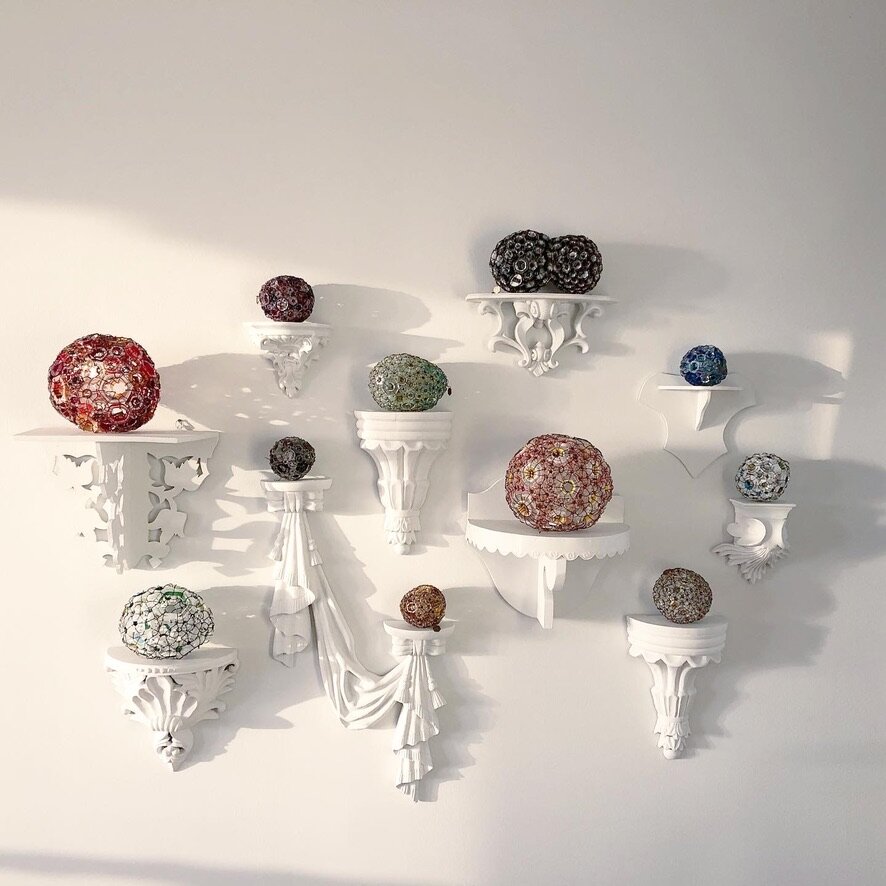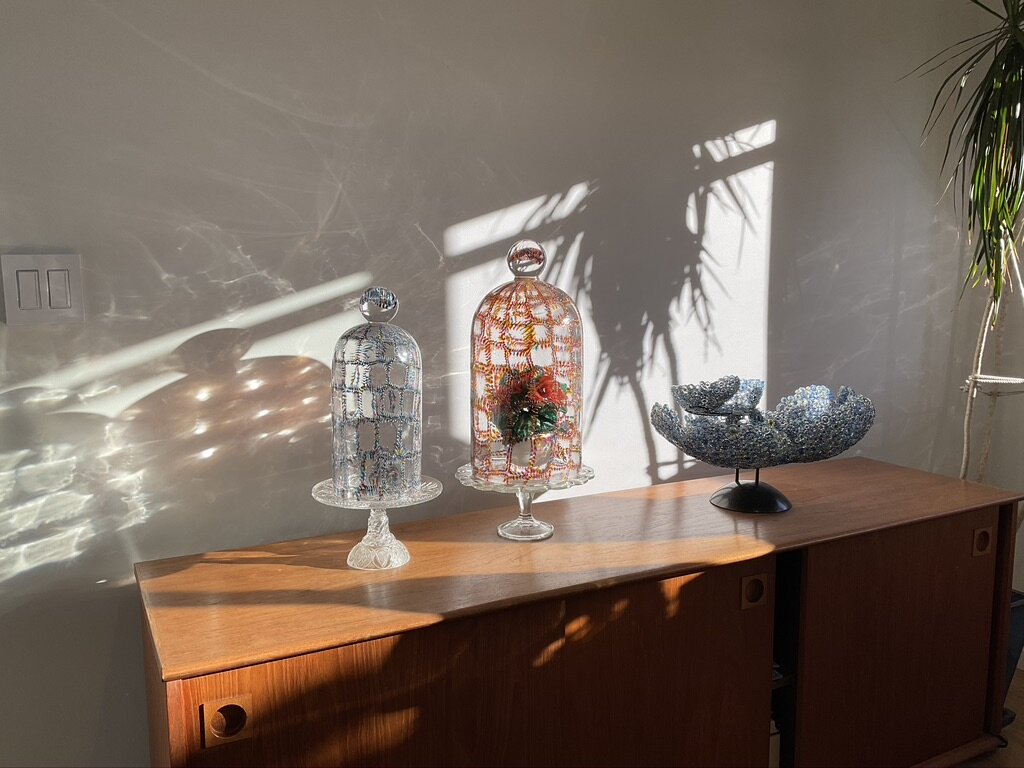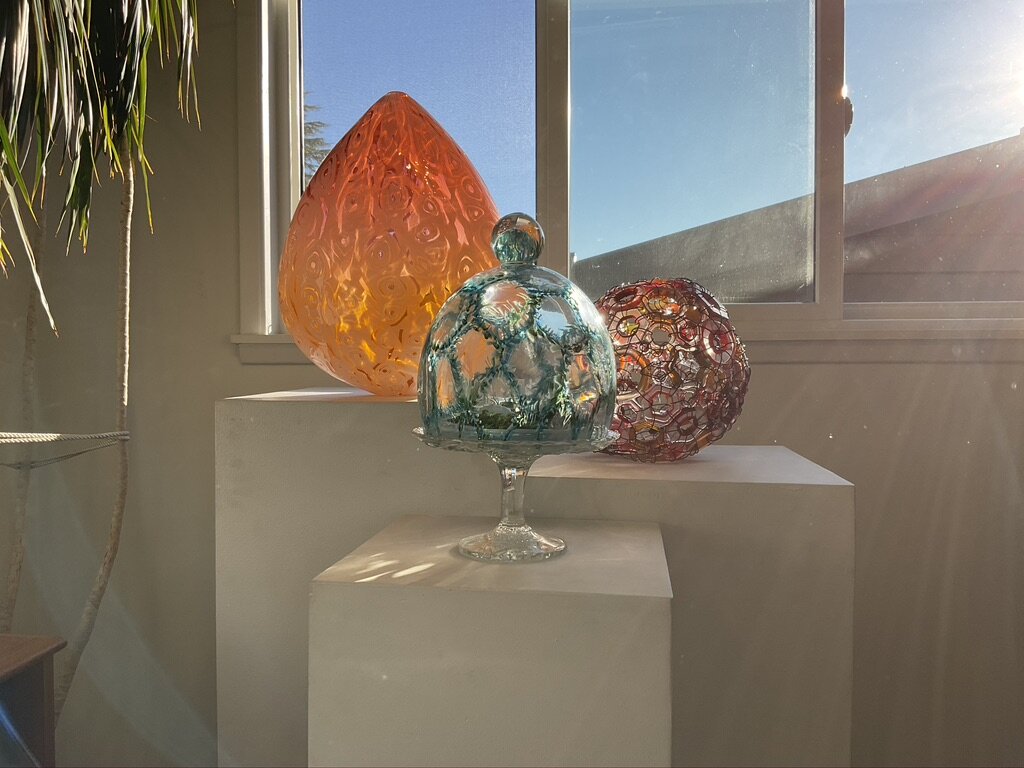weaving her world with glass
Seattle based glass artist Kait Rhoads is currently customizing the garage of her new home to be her studio, her primary workspace where most of the labor on her pieces occurs. While she customarily uses an offsite hot shop to blow vessels and make murrine, the laborious process of fire polishing and weaving together the elements of her soft sculptures happens in the solitary space of her studio. The murrine are usually hexagonal and open in the center, geometric shapes sculpted together to celebrate organic forms. From its inspiration and meaning, to its execution and final presentation, her work has a sense of the order found in nature, born through the creative process.
Ephyria, 2019, in the artists studio.
Rhoads fits together the conical formed hexagonal murrine like the keystones of a Roman arch and thinks of each bead “as an architectural unit” coming together to form something greater, like how cells come together to form a living organism. Rhoads is fascinated by what she calls the “fractal expansion” that happens in this process. “For me to understand how these units go together to make a form, feels like I am discovering a growth pattern in nature. That sort of biology is very exciting to me.” The combination of an asymmetrical aspect of growth systems found in living forms, with the mathematical geometry often found in the order of nature, is the brilliance within her work.
Within the slow process of forming her structural creations is a repetitive weaving action that incorporates a feminine energy. Rhoads has spent as many as three hundred hours on a single piece, intricately working each small fragment of glass into a larger whole, all the while meditating on nature and striving shed light on, through her art, the destruction humanity has wreaked upon the natural world. Her work is an act of loving healing, but it also honors the traditional, matriarchal act of weaving itself. Historically, weaving was considered the lesser form of “craft” and not “art”. This was because women were often the weavers (and “women’s work” could not be “fine art”). For feminist artists like Rhoads, weaving becomes an empowering act of rebellion that directly challenges the ideas of historical acceptability in the world of art.
Often underestimated or left out of the world of glass because of her gender, Rhoads is no stranger to gender discrimination. She does not let this take away from her passion, instead she uses it as fuel. She embraces the culture of her femininity as something that gives her power, instead of something that takes it, and by extension rebels against those who would marginalize her because of her gender. She takes great inspiration from Eva Hesse (1936-1970), the German-born American sculptor and textile artist.
Detail of Verdant, 2019
Art critic Lucy Lippard, speaks of the process in the work of Hesse:
The most salient features of Hesse’s art can be related to her fascination with repetition: “It’s not just an esthetic choice,” she said. “If something is absurd it’s much more greatly exaggerated if it’s repeated. Repetition does enlarge or increase or exaggerate an idea or purpose. I guess repetition feels obsessive.” The wrapping and binding and layering process is also repetitive and makes the viewer relive the intensity of the making in a manner far from the abstract or didactic way in which process is used by most men.
Women are always derogatorily associated with crafts, and have been conditioned towards such chores as tying, sewing, knotting, wrapping, binding, knitting, and so on. Hesse’s art transcends the cliché of ‘detail as women’s work’ while at the same time incorporating these notions of ritual as antidote to isolation and despair. There is that ritual which allows scope to fantasy, compulsive use of the body accompanied by a freeing of the mind. … Repetition can be a guard against vulnerability; a bullet-proof vest of closely knit activity can be woven against fate. Ritual and repetition are also ways of containing anger, and of fragmenting fearsome wholes.
-Lippard, Lucy. Eva Hesse. New York University, New York, 1976. Pg. 209.
“When you look at my work you see the repetition of my linking the glass together with the copper wire, which I have had to develop my own way of doing and I am constantly refining.” Rhoads began learning to macrame around the age of six, and tied decorative nautical knots as a child, particularly in the six years her family lived on a boat in the Virgin Islands. “When we moved onto the boat, I did utilitarian decorative knot tying for the railings, helped my mother maintain the fish nets.” She learned to sew from her grandmother and began her education in costume design (the fluidity of the textile and the slow methodical process attracted Rhoads to working with fabric) before finding glass. Instead of working only in her studio, she brings her work with her to different rooms in her house—like a seamstress works on a garment. This gives her the benefit of seeing the glass in different lights and spaces, so she can play with light to find the right balance. During her process, she keeps in mind that “when you take a piece home, you don’t place it on a pedestal, it often goes on a shelf or furniture.”
Another beautiful aspect of the natural conservation efforts behind Rhoads works is their unique malleability and adaptability. Because of the way she weaves her works, the glass is very strong, embodying the geometric engineering principals of R Buckminster Fuller. She explains that “they are designed to be indestructible, and if something breaks, I can cut the wire and fix it. It has this repairable quality”. In fact, almost nothing goes to waste in the Kait Rhoads studio. She uses “every single little piece” and says “It is part of the Whole Elk Theory, espoused by Dick Marquis, especially these days with the concept of recycling and zero waste. I really like that I can use every little scrap, and nothing is really a throw away—that makes me feel good.” Aware of the environmental impact of her studio, Rhoads reuses and recycles the plastic bags she uses in her process.
This variability in her technique also means that when Rhoads is not pleased with the direction of a work, she can go back, redo, and repurpose materials. This diverges from the more common method of “trashing” or breaking works an artist may feel are not up to par. Rhoads sometimes spends hours on a work only to turn around and dismantle it entirely and begin again, which offers a good explanation as to why she only creates a few pieces each year.
In addition to her woven vessels are her blown Peacock Vessels with simple sloping shapes and wild eye-catching patterns. Inspired by traditional Italian patterns done with murrine, Rhoads conceptualized these works in 1999, and they remain among her most popular and sought-after pieces. Rhoads is inspired by Italian glass patterning tradition, but she doesn’t want to copy directly from her inspiration. “I want to create work that honors those that I have learned from and is truly different [from their work]”. In her Peacock Vessels, she plays with color, pattern, and light in ways only Rhoads truly can. The peacock design, which is her signature, moves with fluid grace and is a reminder of undulating aquatic landscape she grew up in.
The healing and protection of the beauty of nature that Rhoads honors in her work is a creative gesture rooted in fierce feminine energy. Rhoads is careful to pay close attention to each part of the work, large and small, to create something extraordinary. As her new sustainable studio evolves, it will be wonderful to see the new and exciting creations to come.
Typhon, 2015
“How does she do that?”
Hollow Murrini Process Demo with Kait Rhoads…
… and A Very Quick Weaving Demo!
Available works
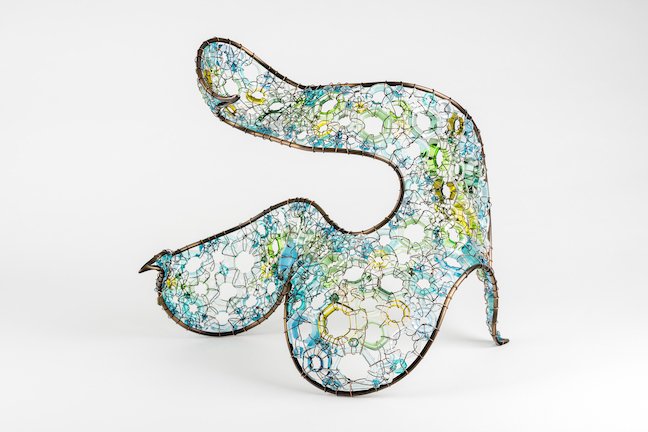
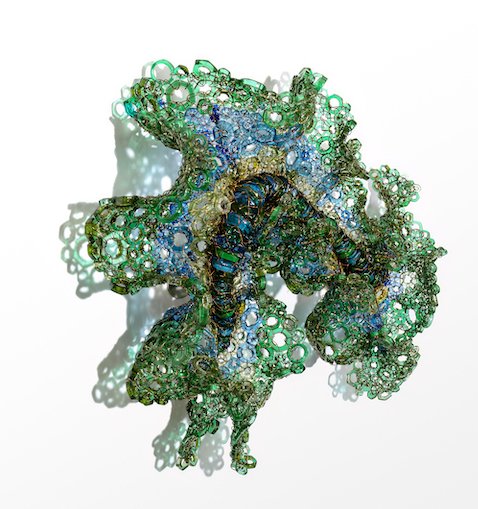
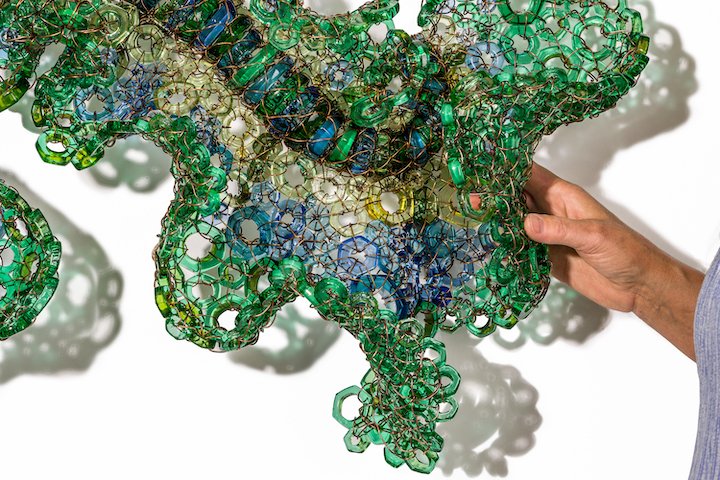
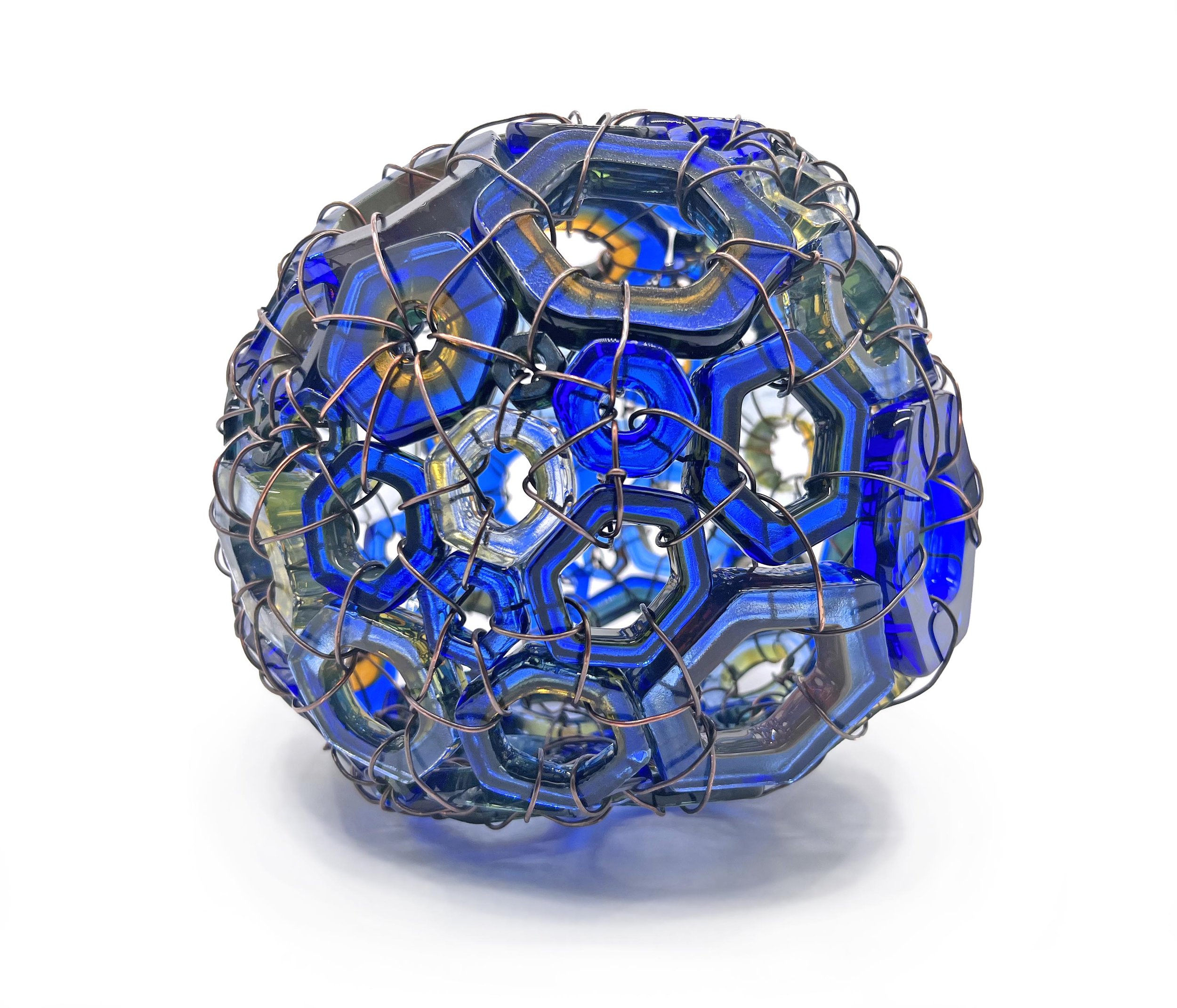
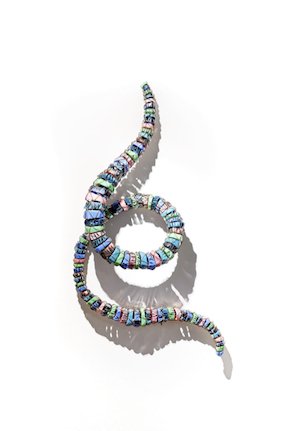
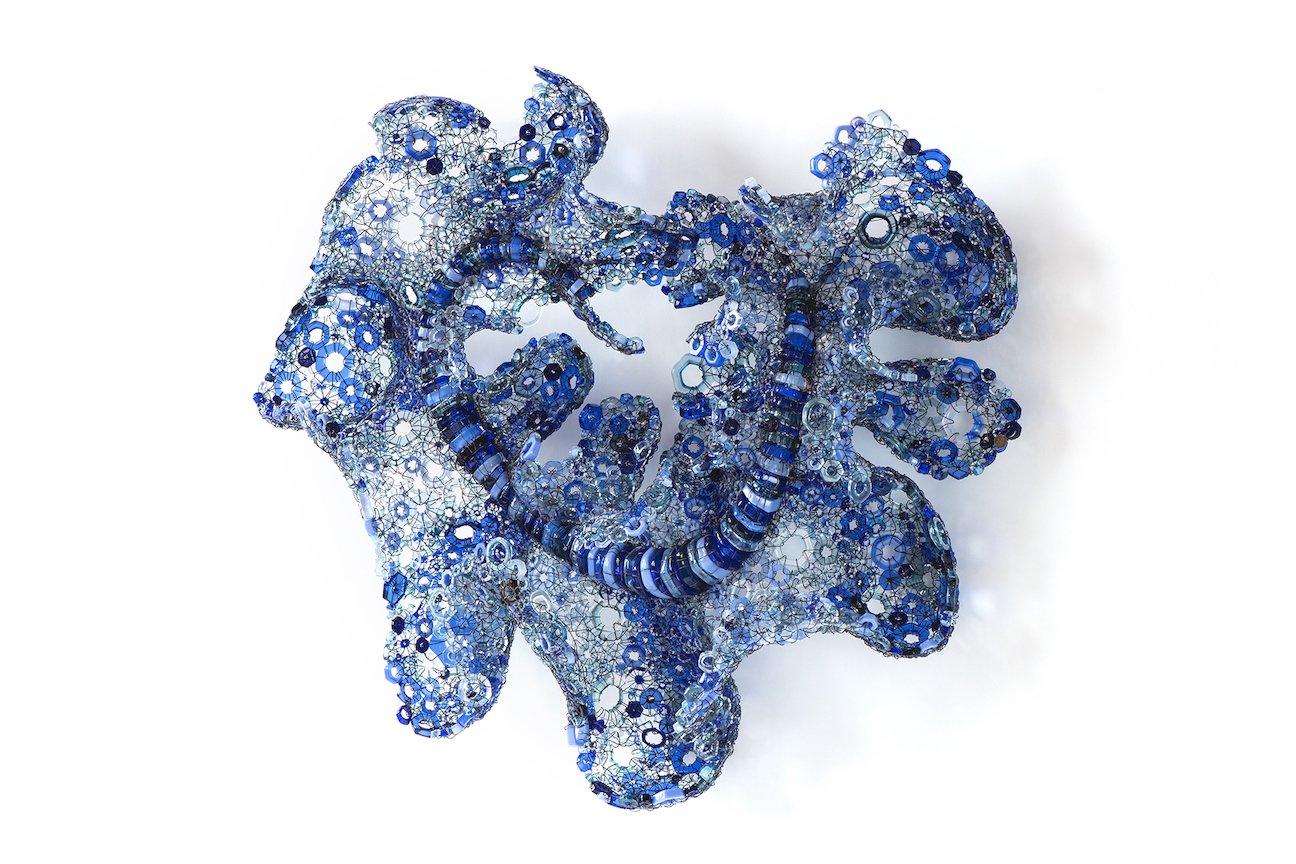
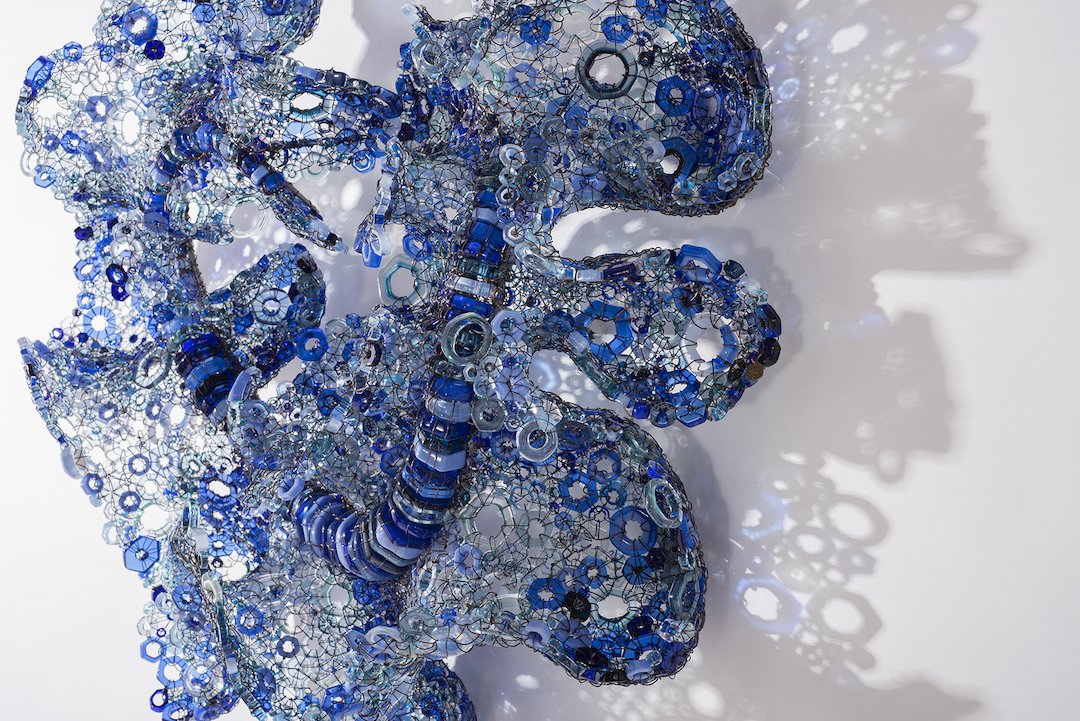
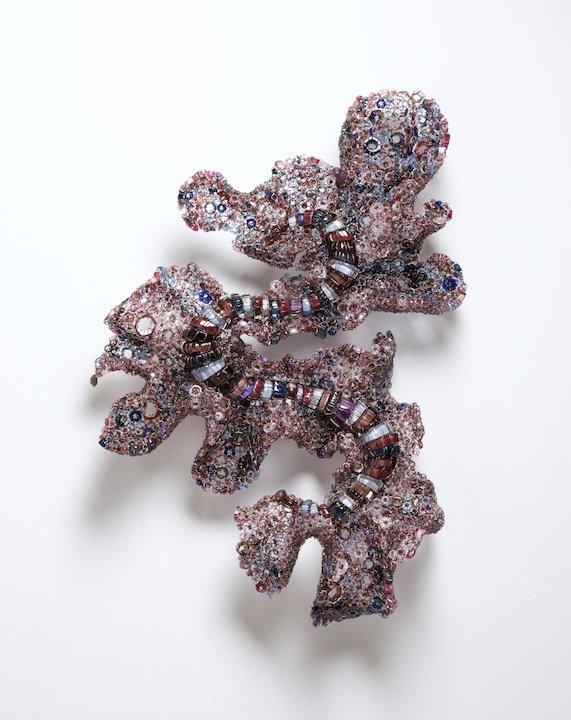
Kait Rhoads received her BFA in Glass from the Rhode Island School of Design in 1993, and her MFA in Glass from Alfred University, NY in 2001. She has been an Artist in Residence at the Pratt Fine Arts Center in Seattle, WA, and the recipient of numerous awards, including the Doug and Dale Anderson Scholarship, The Anne Gould Halberg Award, and a Fulbright Scholarship for the study of sculpture in Venice, Italy. She has worked as an instructor at the Haystack Mountain School of Crafts, Deer Isle, Maine, the Penland School of Crafts, the Studio at the Corning Museum of Glass, Alfred University, and the Pratt Fine Arts Center in Seattle, where she was a teaching assistant for Lino Tagliapietra.
Education
1999-01 MFA in Glass, Alfred University, New York State College of Ceramics, Alfred, NY.
1989-93 BFA in Glass, Rhode Island School of Design, Providence, RI.
1985-89 Atrium Baccalaureate in Creative Arts, Rollins College, Winter Park, FL.
Public & Private Collections
Carnegie Museum of Art, Pittsburg, PA.
Corning Museum of Glass, Corning, NY.
Glasmuseum, Ebeltoft, Denmark.
Museum of Glass International Center for Contemporary Art, Tacoma, WA.
Museum of Northwest Art, LaConner, WA.
New Renaissance Hollywood Hotel, Hollywood, CA.
Seattle Art Museum, Seattle, WA.
Toyama Institute of Glass Museum, Toyama, Japan.
Selected Exhibitions
2019 Salmon School Ambassadors, Schack Arts Center, Everett WA.
Solo Show, Scheipers Gallery, Hasselt, Belgium. 2018
Glasstastic, Bellevue Art Museum, Bellevue, WA.
NO GLASS Ceiling! Women working in Glass, Part 1 Palm Springs Art Museum, CA.
Making our Mark, Bellevue Art Museum, Bellevue, WA.
2017 Selections from the Anne Gould Hauberg Collection. Tacoma Art Museum, Tacoma, WA. Revering Nature, Bainbridge Island Museum of Art, Bainbridge, WA.
Into the Deep, Tacoma Museum of Glass, Tacoma, WA. 2016 LifeForms
2016, Pittsburg Glass Center, Pittsburg PA.
LifeForms 2016, Ceder Gallery, Corning, NY.
Into the Deep, Tacoma Museum of Glass, Tacoma, WA.
The Nature of Glass, Chesterwood, Stockbridge MA.
2015 All Natural, Curator and participant, The Schack Arts Center, Everett, WA.
Sculpture Walk – Wandering Diatoms, Temporary public art, Seattle Center, Seattle, WA
Game Changers: Fiber Art Masters and Innovators, Fuller Craft Museum, Brockton, MA. 2014 Lake Effect, Saugatuck Center for the Arts, Saugatuck, MI.
Tidal, Chihuly Collections, St Petersburgh, FL.
Shattered: Contemporary Sculpture in Glass, Frederik Meijer Gardens & Sculpture Park, MI. Accreted Terrane, Museum of Northwest Art, La Conner, WA.
2013 The Cutting Edge, Racine Art Museum, WI.
Fluid Reformations, Islip Art Museum, Islip, NY. 2012 50 Years of Studio Glass, Kentucky Museum of Art and Craft, Louisville, KY.
2011 Contemporary Glass, Palm Springs Art Museum, Palm Springs, CA.
2010 Transformation 6: Contemporary Works in Glass, Hunter Museum of Art, Chattanooga, TN.
2009 12th Annual Whidbey Island Glass Invitational, Museo, Langley, WA.
BIGG: Breakthrough Ideas in Global Glass Exhibition, OSU Urban Arts Space, Columbus, OH.
As Below, So Above, Northwest Museum of Art, LaConner, WA.
Beautifully Crafted, National Glass Centre, Sunderland, UK.
Selections from the Permanent Collection, Museum of Northwest Art, LaConner, WA.
Transformation 6: Contemporary Works in Glass, Western Gallery at Western
Washington University, Bellingham, WA.
2008 Transformation 6: Contemporary Works in Glass, Philadelphia Art Alliance, PA.
Beautifully Crafted, National Glass Centre, Sunderland, UK.
Glorious Glass: Translucent and Opaque, the Arts Center, St Petersburg, FL.
A Clear Mind: Glass Invitational, Figge Art Museum, IL.
2007 Shattering Glass, New Perspectives, Katonah Museum of Art, Katonah, NY.
Transformation 6: Contemporary Works in Glass, Society for Contemporary Craft, Pittsburgh, PA.
Viva Vetro! Glass Alive! Venice and America, 1950-2006, Carnegie Museum of Art, Pittsburgh, PA.
Behind Glass: Creativity and Collaboration, The Arts Center, St Petersburg, FL.
Glass Lover's Weekend, Milleville, NJ.
SOFA Chicago, New York and PB3.
2006 Brilliant: Celebrating Pilchuck Glass, Sea-Tac International Airport, Seattle, WA.
2005 Brilliant: Celebrating Pilchuck Glass, Sea-Tac International Airport, Seattle, WA.
2004 Italian Influence in Contemporary Glass, The Corning Museum of Glass, Corning, NY.
Vetri. Nel mondo. Oggi, Istituto Veneto di Scienze Lettere ed Arte, Venice, Italy.
2003 20/20 Vision, Museum of American Glass, Millville, NJ.
2002 Peacock Vessels, Vetri International Glass, Seattle, WA.
Under 40, Scuola del Vetro Abate Zanetti, Murano, Italy.
2001 Master of Fine Arts Thesis Exhibition, Alfred University, Alfred, NY.
Visionary Women, Bausch & Laumb, Rochester, NY.
Distractions, 171 Cedar Arts Center, Corning, NY.
2000 Solo Show, Northwest Museum of Art, La Conner, WA.




